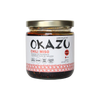We use Haiga-mai (half-milled rice/haiga-rice) for our onigiri. It's neither brown nor white rice, but somewhere in between the two. It is commonly believed that brown rice provides more nutrition when compared to white rice, but if we consider the amount of nutrition made useful through digestion, this belief may not be entirely true.
The Myth of Brown Rice
Brown rice is thought of as very nutritious when compared to white rice, but the benefit is actuary quite limited.
Japanese researcher Satoru Eguchi says:
"In fact, brown rice, often believed to be the grain's healthiest incarnation, turns out to be the worst option, when it comes to this angiotensin-blocking compound."
"Most of the nutritious part cannot really be digested, because the brown rice shell is so hard," he explains. "We actually cannot really absorb the nutrition. And to make the brown shells sufficiently soft to digest, you need to cook rice longer, need more heat, [so you are] not really keeping that protective ingredient." [sic]
"White rice cooks for less time, but most of that nutritious inner layer has been polished off to get that light and fluffy texture."
Eguchi presents HAIGA-MAI as a third option.
"It's possible to 'half polish' rice — or to polish away the hard outer shell, while leaving the nutritious inner layer intact. By this way you can most effectively digest the nutritious part. In Japan, that style of rice is called haiga-mai. Eguchi says among some Japanese, it is already a popular choice, because of perceived health benefits." [sic]
*Source:"Rice Could Help Prevent Heart Attacks",Voice of America, 2010;
http://www.voanews.com/content/rice-could-help-prevent-heart-attacks/171133.html
|
Best sauce for Haigamai
|
Haiga-mai is milled to remove only the outer bran layer, leaving the germ (haiga), intact. The result is a grain that is more tan in colour than white rice, but considerably paler than brown rice.Here is a comparison of the nutritional make up of white rice and haiga-mai:
*Source: Standard Tables of Food Composition in Japan
The glycemic index of haiga-mai is 70. This falls between rice rice's 88 and brown rice's 55. All three rice options have a lower glycemic index than most types of bread.
Tamaki Haiga - Shortgrain Rice
The History of Haiga-mai
It was during the Edo era (1603–1868) that the eating of white rice became widespread. It was during this same period that the occurrence of beriberi (a disease caused by thiamine deficiency) amongst wealthy city dwellers who could afford polished white rice became so prevalent that is was commonly referred to as "Edo disease."
During the Japanese-Russo War (1904-1905), the Japanese military experienced 80,000 deaths amongst its ranks, 14,000 of these were caused by beriberi. At this time, the cause of the disease was still a mystery.
In 1924, Dr. Junjiro Shimazono, a professor at The University of Tokyo, determined that the cause of beriberi is a lack of Vitamin B1, and advocated for the eating of haiga-mai instead of white rice as diet staple.
|
Related article
|
In 1928, a government panel of health experts recommended that a "prohibition of white rice, which has been stripped of its germ" was needed, and this became the origin of widespread Haiga-mai production and consumption in Japan.
After World War 2, cheap manmade vitamins were introduced to the market and vitamin enriched white rice overtook haiga-mai's popularity.
These days in Japan, haiga-mai has attracted attention as a natural way to obtain better nutrition.
*Source1:Japan Science and Technology Information Aggregator, Electronic;
https://www.jstage.jst.go.jp/article/cookeryscience1968/11/1/11_51/_pdf
*Source2;Fukushima Diichi Nogyo Kumiai,2006;
http://www.f-daiichi.or.jp/100_shouhin/130_tokuchou.html
Haiga-mai Tastes Good Too
Haiga-mai's benefits are not only nutritional, but in taste and texture too. It isn't as hard as brown rice, and it has richer flavour than white rice.
When we started making onigiri in North America, we were determined to use haiga-mai despite it's higher cost and more difficulty in sourcing it. If we were to encourage the eating of rice to consumers who were not accustomed to eating much rice, we were determined to introduce our customers to the rich taste and nutritional benefits of haiga-mai.
We hope you enjoy haiga-mai when eating Abokichi onigiri!!
-Abokichi
Related article
4 Things You Need to Know Before Buying a Rice Cooker
You Should Never Buy a Rice Cooker that is Too Big for Your Needs
Tamaki Haiga - Shortgrain Rice





